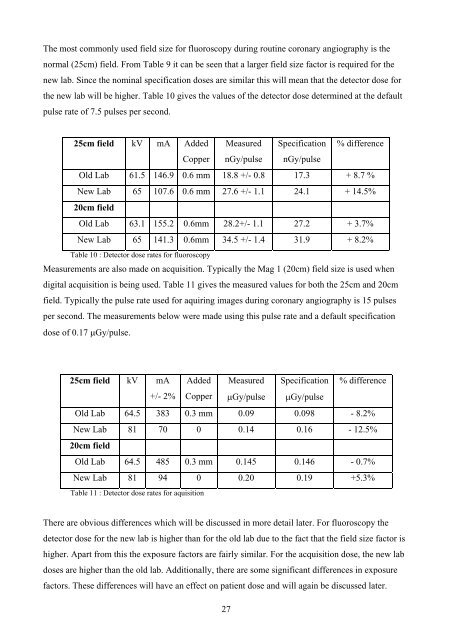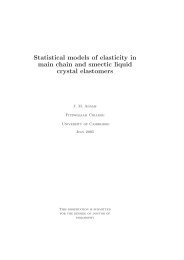Sandra Hopkins Final Report.pdf - University of Surrey
Sandra Hopkins Final Report.pdf - University of Surrey
Sandra Hopkins Final Report.pdf - University of Surrey
You also want an ePaper? Increase the reach of your titles
YUMPU automatically turns print PDFs into web optimized ePapers that Google loves.
The most commonly used field size for fluoroscopy during routine coronary angiography is thenormal (25cm) field. From Table 9 it can be seen that a larger field size factor is required for thenew lab. Since the nominal specification doses are similar this will mean that the detector dose forthe new lab will be higher. Table 10 gives the values <strong>of</strong> the detector dose determined at the defaultpulse rate <strong>of</strong> 7.5 pulses per second.25cm field kV mA Added Measured Specification % differenceCopper nGy/pulse nGy/pulseOld Lab 61.5 146.9 0.6 mm 18.8 +/- 0.8 17.3 + 8.7 %New Lab 65 107.6 0.6 mm 27.6 +/- 1.1 24.1 + 14.5%20cm fieldOld Lab 63.1 155.2 0.6mm 28.2+/- 1.1 27.2 + 3.7%New Lab 65 141.3 0.6mm 34.5 +/- 1.4 31.9 + 8.2%Table 10 : Detector dose rates for fluoroscopyMeasurements are also made on acquisition. Typically the Mag 1 (20cm) field size is used whendigital acquisition is being used. Table 11 gives the measured values for both the 25cm and 20cmfield. Typically the pulse rate used for aquiring images during coronary angiography is 15 pulsesper second. The measurements below were made using this pulse rate and a default specificationdose <strong>of</strong> 0.17 µGy/pulse.25cm field kV mA Added Measured Specification % difference+/- 2% Copper µGy/pulse µGy/pulseOld Lab 64.5 383 0.3 mm 0.09 0.098 - 8.2%New Lab 81 70 0 0.14 0.16 - 12.5%20cm fieldOld Lab 64.5 485 0.3 mm 0.145 0.146 - 0.7%New Lab 81 94 0 0.20 0.19 +5.3%Table 11 : Detector dose rates for aquisitionThere are obvious differences which will be discussed in more detail later. For fluoroscopy thedetector dose for the new lab is higher than for the old lab due to the fact that the field size factor ishigher. Apart from this the exposure factors are fairly similar. For the acquisition dose, the new labdoses are higher than the old lab. Additionally, there are some significant differences in exposurefactors. These differences will have an effect on patient dose and will again be discussed later.27
















